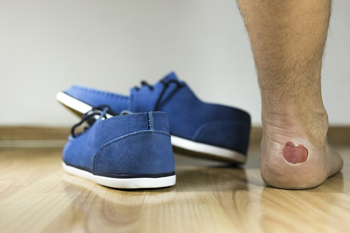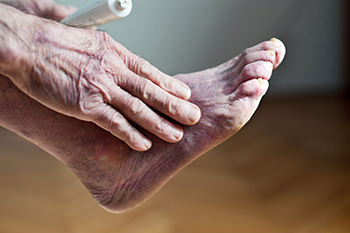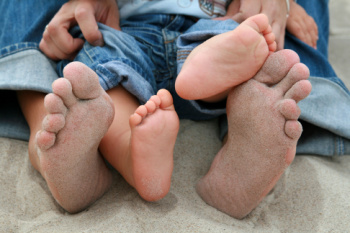Blisters are fluid-filled bubbles of skin that can appear on any part of the body and are particularly common on the feet. Most foot blisters form due to friction. As you walk, run, or go about your daily activities, your shoes may rub against specific areas of your feet, causing the skin to become damaged. The top layer of skin then separates from the lower layers of skin. The area between the separated layers fills with a fluid called serum, whose purpose is to cushion and protect the raw skin below the blister.
If you find a friction blister on your foot, it is highly recommended that you do not pop it. Popping the blister drains the fluid inside of it and exposes the raw skin underneath, increasing your risk of infection. Instead, protect the blister by loosely covering it with a bandage. You can also use special padding around the blister to protect it. Typically, friction blisters naturally heal over the course of one to two weeks. Friction blisters can be prevented by wearing well-fitted shoes and moisture-wicking socks. Wearing soft bandages over areas of your foot that tend to blister may also help.
Sometimes foot blisters can be caused by problems other than friction. Blisters can develop due to a sunburn, frostbite, or exposure to an allergen, as well as from medical conditions such as fungal infections or eczema. If you frequently find blisters on your feet, it is recommended that you consult with a podiatrist.

Blisters on the feet are a common issue for runners, usually caused by friction and moisture. Friction arises from repeated rubbing between the skin and footwear, while moisture from sweat or wet conditions softens the skin, making it more prone to form a blister. Wearing Ill-fitting shoes and high-impact activities like running can worsen these problems, as do hot and humid weather, and foot conditions like bunions or hammertoes. Proper footwear selection is vital, opting for shoes that fit well and offer sufficient toe space. Wearing moisture-wicking socks and applying lubricants like petroleum jelly can help keep feet dry and reduce friction. Gradual conditioning of the feet by slowly increasing running distances and intensity also helps the skin adapt and become more resilient. Protective padding, such as moleskin, can be applied to vulnerable areas to reduce friction and pressure. Regular foot care, including trimming toenails, addressing calluses and moisturizing, contributes to overall foot health and reduces blister risk. For guidance with painful or infected blisters, it is suggested that you schedule an appointment with a chiropodist.
Blisters can usually be treated at home, however, if you have recurring blisters or experience significant discomfort or pain, please consult with one of the chiropodists from The Footcare Centre. Our chiropodists will assess your condition and provide you with quality foot and ankle treatment.
What Is a Blister?
A blister is a small pocket of fluid in the upper skin layers and is one of the body’s natural responses to injury or pressure. Blisters can also result from burns, fungal or viral skin infections, and the feet are particularly prone due to ill-fitting footwear and friction. Friction on the skin causes the upper layer of skin to separate from the lower layers. The space that this separation creates then becomes filled with a liquid called serum, which protects the lower layers of skin.
Treatment
If you notice a blister on your foot, you can cover it with a soft bandage or dressing to protect it. Popping the blister is discouraged. Doing so exposes the raw skin underneath it to bacteria and also raises the risk of infection. If a blister pops naturally, let it drain before covering it with a bandage. Blisters usually heal on their own or with home treatment, however, if your blister is recurring, very painful, or appears infected, it is recommended that you see a chiropodist for treatment.
Prevention
You can help to prevent blisters by wearing comfortable, well-fitted shoes. Keep your feet dry by wearing moisture-wicking socks and dust your feet with talcum powder if they tend to get sweaty. If you have areas on your feet that are more susceptible to blisters, you might be able to prevent the blister from forming by covering it with a pad.
If you have any questions, please feel free to contact our office located in . We offer the newest diagnostic and treatment technologies for all your foot care needs.
Poor circulation in the lower limbs is typically caused by atherosclerosis, the narrowing and hardening of arteries due to a buildup of plaque. However, there are other causes, such as blood clots, varicose veins, diabetes, obesity, and Raynaud’s disease. When there is inadequate blood flow to the lower limbs, their tissues do not receive enough oxygen and nutrients to stay healthy. This can produce symptoms such as muscle cramps, fatigue, weakness, coldness, numbness and tingling, hair loss, and discoloration. Additionally, any wounds that form on the feet and ankles may heal slowly and poorly due to an insufficient blood supply.
Poor circulation in the lower limbs can seriously affect your quality of life. Its symptoms can make it difficult to walk, stand, and get around in day-to-day life. Furthermore, if left untreated, poor circulation can greatly increase one’s risk of having a cardiovascular event, such as a heart attack or stroke.
In some cases, people with poor circulation do not experience any symptoms and may be unaware that they even have this problem. Because of this, it is important to get regular screenings. This is especially true if you are at risk of having poor circulation. People with an increased risk include adults over the age of 60 and those with a personal or family history of cardiovascular disease, high cholesterol, high blood pressure, or diabetes.
To learn more about poor circulation in the lower limbs, get screenings, and find the right treatments for you, please consult with a chiropodist.

Poor foot circulation can stem from various underlying factors, impacting the flow of blood to your feet and leading to discomfort and other symptoms. One common cause is peripheral artery disease, or PAD, which occurs when arteries become narrowed or blocked, restricting blood flow to the extremities. Diabetes can also contribute to circulation issues, as high blood sugar levels can damage blood vessels over time. Additionally, conditions like obesity, high blood pressure, and smoking can exacerbate circulation problems by further constricting blood vessels. Symptoms of poor foot circulation may include cold feet, numbness or tingling, swelling, cramping, and slow-healing wounds. If left untreated, these symptoms can escalate into more serious complications, such as ulcers or infections. It is vital to address the root cause of poor circulation through lifestyle changes or medication. If you are experiencing any of the above symptoms, it is suggested that you consult a chiropodist who can successfully treat poor circulation.
Poor circulation refers to a lack of adequate blood flow in the body. The feet and ankles are frequently affected by poor circulation. If you have symptoms of poor circulation, please consult with one of the chiropodists from The Footcare Centre. Our chiropodists can help you maintain the health of your lower limbs and your mobility.
What causes poor circulation?
Poor circulation is typically caused by a buildup of a fatty substance called plaque in the arteries that supply the lower limbs. When plaque accumulates, it causes the blood vessels to narrow and harden, making it harder for blood to move through them. Without an adequate blood supply, the lower limbs do not receive enough oxygen and nutrients to stay healthy. This can produce a variety of symptoms, especially as the condition progresses.
For some people, there are no noticeable symptoms. If symptoms do arise, they can include
Muscle cramps
Weakness
Fatigue
Pain that gets worse with physical activity
Balance problems
Difficulty walking
Wounds that heal poorly
Hair loss
Discoloration
Coldness
Other causes of poor circulation include blood clots, varicose veins, diabetes, obesity, and Raynaud’s disease.
Screening
Your chiropodist can perform a variety of simple, safe, and noninvasive screenings to assess the circulation in your lower limbs. One common vascular test is the Ankle-Brachial Index (ABI) test. During an ABI, the chiropodist measures your blood pressure in your arms and ankles and compares the two numbers to derive a ratio. The ratio is then used to determine your risk of having poor circulation. Another screening measure is a Doppler ultrasound, where sound waves are used to image the blood flow in the lower limbs.
Who is at risk?
Those most at risk of having poor circulation are older adults and people with a personal or family history of cardiovascular disease. If you are at risk, it’s suggested that you schedule an appointment with a chiropodist.
If you have any questions, please feel free to contact our office located in . We offer the newest diagnostic and treatment technologies for all your foot care needs.
Good foot care is proactive, rather than reactive. While a chiropodist can diagnose, treat, and help you manage a variety of foot and ankle conditions, preventing foot problems and keeping the feet healthy is something that you can do at home as well. Having and following an established daily foot care routine can be very beneficial.
Maintaining good foot hygiene helps prevent a variety of foot problems, including infections like athlete’s foot and fungal toenails. It is important to wash your feet every day using lukewarm water and mild soap. Wash the entire foot, from heel to toe. Then dry the foot thoroughly, taking extra care to dry in between the toes. Moisturizing the heels and soles of the feet after washing them can help keep the skin soft, hydrated, and free of cracks.
Stretching and strengthening the feet can maintain or improve their mobility. There are many easy foot exercises that you can do to keep your feet strong and flexible, such as toe scrunches and heel raises. Maintaining a healthy diet and exercising regularly can help keep your weight under control, relieving excess pressure and strain on the feet.
Finally, wearing the right shoes is one of the easiest ways to care for the feet. Many people wear shoes that are too tight or narrow, shoes that don’t support the feet adequately, and shoes that are made of materials that trap moisture on the foot. Opt for comfortable, properly-fitted shoes that support and protect your feet.
For more information about daily foot care practices for good foot health, please consult with a chiropodist.

Maintaining proper foot care is essential for overall well-being and mobility, yet it is often overlooked in daily routines. Establishing a regular foot care regimen can promote foot health and prevent common problems. Start by cleansing your feet daily with mild soap and warm water, ensuring to dry them thoroughly, paying extra attention to the spaces between toes. Next, inspect your feet for any abnormalities such as cuts, blisters, or changes in skin color or texture. Trim toenails straight across to prevent ingrown toenails, and moisturize your feet to keep skin hydrated and supple. Wear well-fitting, supportive footwear suitable for your activities, and consider using cushioned insoles or orthotic inserts for added comfort and support. Additionally, engage in foot strengthening exercises and gentle stretches to improve flexibility and prevent injuries. If you have developed foot conditions from not having a good foot care routine, it is suggested that you visit a chiropodist who can guide you toward effective care methods.
Caring for your feet is not just something done at the chiropodist’s office. Good foot care starts at home. If you would like to learn more about daily foot care practices, please consult with one of the chiropodists from The Footcare Centre. Our chiropodists can help you maintain the health of your lower limbs and your mobility.
There are many things that you can do at home to help care for your feet, including:
Wearing shoes and socks that fit properly
Washing the feet daily with soap and water
Drying the feet thoroughly
Applying moisturizer to the soles and heels of the feet
Taking a walk and exercising the feet regularly
Doing foot stretches and strengthening exercises
A chiropodist can help figure out a manageable foot care routine for you to keep your feet healthy. If you have any questions, please feel free to contact our office located in . We offer the newest diagnostic and treatment technologies for all your foot care needs.
Summer can be a time when the feet are particularly vulnerable to various medical problems. This is because the warm weather means that many people will wear shoes that do not adequately cushion and protect the feet or will go barefoot entirely. Fortunately, most summertime foot problems can be treated or prevented.
In the summertime, most people frequent warm, moist public areas, such as swimming pools, locker rooms, and showers, walking around barefoot. These places are breeding grounds for various fungi and viruses that can get into the feet, causing an infection. Tinea pedis, or athlete’s foot, is a fungal infection of the skin on the feet. It’s characterized by a red, scaly, itchy rash and skin peeling, usually found between the toes. Fungus can also infect the toenails, making them brittle, crumbly, thickened, and discolored. Human papillomavirus (HPV) is a common viral infection that can cause benign, fleshy growths called warts to grow on the soles of the feet. When going to public places, it’s suggested that you wear shoes to protect your feet from infectious agents and that you avoid sharing personal items like shoes and towels with others.
For many people, staple summer footwear includes flip-flops and open-back, open-toe sandals. Unfortunately, these shoes are usually flimsy and don’t protect the feet or provide any support or cushioning. Some also require you to scrunch up your toes while you walk to keep the shoes on your feet. This can lead to a variety of foot and ankle injuries, heel pain, arch pain, bunions, hammertoes, and dry, cracked heels. When shopping for summer shoes, look for shoes that fit properly and have adequate cushioning in the heel and arch area. They should stay on your feet while you walk without any effort and protect your feet from the elements. If you must wear flip-flops, limit wear to just a few hours every few days, or when going to specific places like the pool or beach.
For more information about common summer foot problems and how to treat and prevent them, please consult with a chiropodist.

Getting your feet summer-ready is a breeze with a few simple steps. Start by exfoliating to remove dry, dead skin, leaving your feet smooth and soft. Moisturize daily to keep skin hydrated and prevent cracking, focusing on heels and other rough areas. Trim toenails straight across to avoid ingrown nails, and remember to apply sunscreen to protect against harmful UV rays. When it comes to footwear, opt for breathable sandals with proper arch support to prevent discomfort and blisters. Be mindful of spending too much time barefoot, especially on hot surfaces, to avoid burns and injuries. Lastly, if you have concerns about foot health or need personalized tips for summer foot care, it is suggested that you schedule an appointment with a chiropodist who can offer you expert advice and treatments to ensure your feet are happy and healthy all summer long.
Summer is the season for many foot and ankle issues. If you’re suffering from a foot or ankle problem, please consult with one of the chiropodists from The Footcare Centre. Our chiropodists can help you maintain the health of your lower limbs and your mobility.
Common Summer Foot Problems
Athlete’s foot
Toenail fungus
Plantar warts
Foot and ankle injuries
Bunions
Hammertoes
Heel pain
Cracked heels
Sunburns
Blisters
Prevention
Wear supportive shoes and avoid flip-flops
Maintain good foot hygiene
Exfoliate and moisturize the heels
Apply sunscreen to the feet and ankles
Wear shoes in public areas like swimming pools, locker rooms, and showers
If you have any questions, please feel free to contact our office located in . We offer the newest diagnostic and treatment technologies for all your foot care needs.


